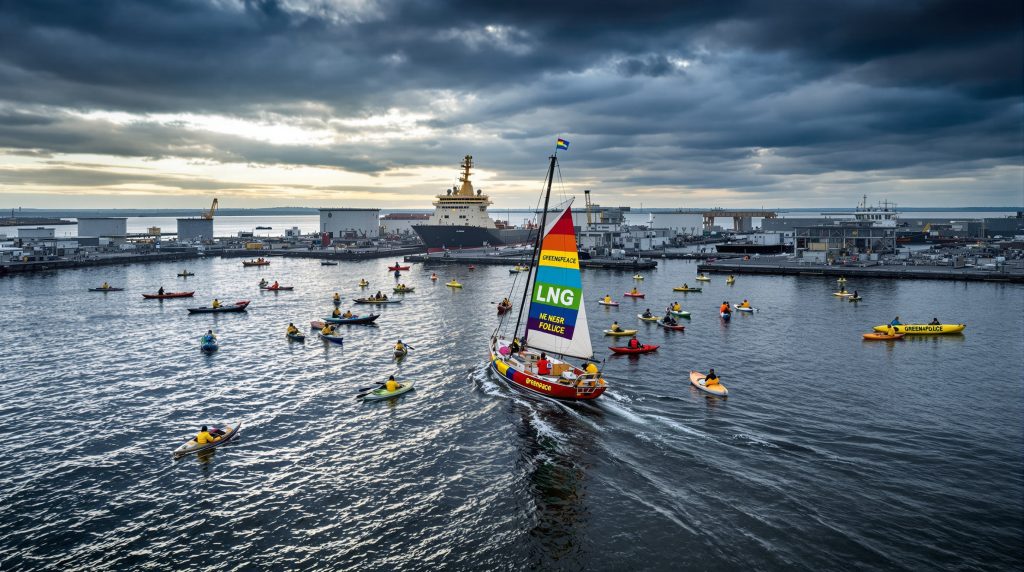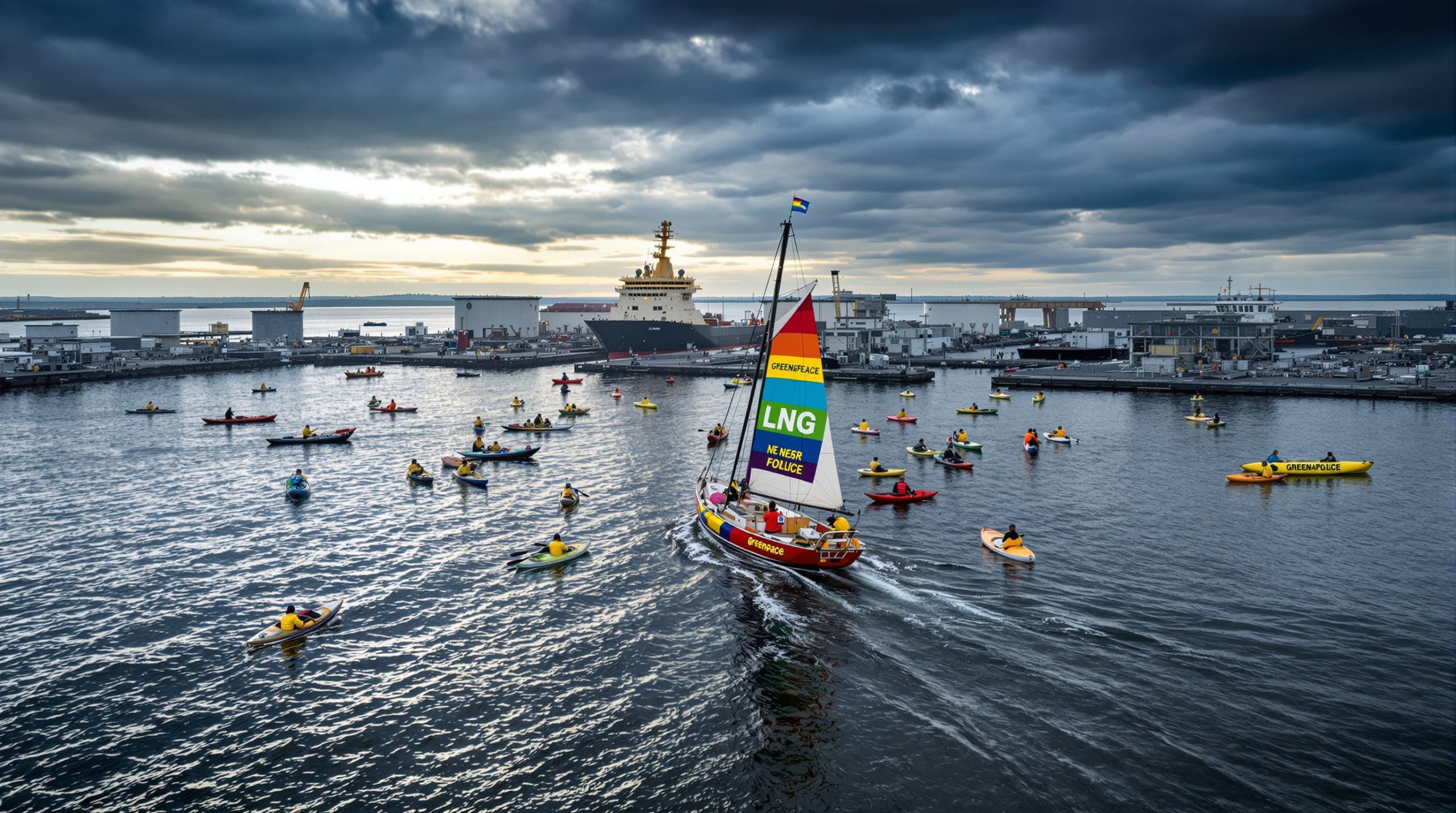How Did Greenpeace's Blockade Impact LNG Shipments?
Environmental activists from Greenpeace staged a significant blockade at Belgium's Zeebrugge LNG terminal on October 1, 2025, forcing multiple liquefied natural gas tankers to divert their routes. The coordinated action, involving protesters from 17 countries, successfully prevented vessels from docking at one of Europe's key gas import facilities for nearly 30 hours before authorities intervened.
Using a fleet of small watercraft including kayaks, inflatable boats, and a sailing vessel, activists physically occupied the terminal's access channel, creating an effective maritime blockade that disrupted scheduled deliveries while internal terminal operations continued unaffected. This protest highlighted ongoing energy transition challenges facing Europe as it attempts to balance security concerns with climate commitments.
Why Did Greenpeace Target Belgium's Zeebrugge Terminal?
Strategic Significance of the Terminal
Zeebrugge represents a critical energy infrastructure node for the European Union, serving as:
- The largest entry point for Russian LNG into the European market
- A major receiving terminal for increasing volumes of US liquefied natural gas
- A strategic energy security asset for Belgium and neighboring countries
- A key component in Europe's diversification strategy away from pipeline gas
The terminal's dual role in handling both Russian and American LNG made it a symbolically powerful target for environmental activists seeking to highlight Europe's continued fossil fuel dependencies from geopolitically significant sources.
Greenpeace's Strategic Objectives
The environmental organization chose this specific terminal to spotlight several interconnected concerns:
- Climate Impact: Challenging Europe's long-term reliance on fossil gas despite climate commitments
- Geopolitical Entanglement: Highlighting how European gas imports financially support Russia's military activities
- Environmental Justice: Raising awareness about extraction impacts of US shale gas production
- Energy Transition Acceleration: Pressuring the EU to expedite renewable energy deployment
The timing aligned with ongoing EU discussions about potentially banning Russian LNG imports starting January 2027 as part of a broader sanctions package, coming amid escalating US–China trade tensions that further complicate global energy markets.
Which LNG Tankers Were Forced to Divert?
Confirmed Vessel Diversions
| Vessel Name | Origin | Cargo Type | Diversion Status |
|---|---|---|---|
| Megara | United States | US LNG | Changed course |
| Rias Baixas Knutsen | United States | US LNG | Changed course |
| LNG Phecda | Russia | Russian LNG | Changed course |
| Arctic Voyager | Norway | Norwegian LNG | Delayed, not diverted |
The diversions affected shipments from both major Western and Russian sources, underscoring Greenpeace's position that their protest targeted fossil fuel dependency broadly rather than specific geopolitical sources.
Economic and Supply Chain Impacts
While the terminal's internal operations and output flows remained unaffected during the protest, the forced diversions created:
- Short-term scheduling disruptions for gas suppliers
- Potential contractual complications for delivery commitments
- Increased shipping costs for diverted vessels
- Temporary uncertainty in regional gas trading markets
Industry analysts noted that the relatively short duration of the blockade limited serious market impacts, though it demonstrated the vulnerability of maritime energy supply chains to coordinated activist interventions and highlighted potential trade war supply disruptions that could affect energy security.
How Did Authorities Respond to the Blockade?
Law Enforcement Intervention
After allowing the protest to continue for nearly 30 hours, Belgian authorities ultimately moved to end the blockade:
- Maritime police units were deployed to the terminal's access channel
- Protesters were systematically removed from their positions
- Activists were detained for questioning regarding potential violations of port security regulations
- Normal terminal operations resumed following the clearance operation
The authorities' measured response reflected the balance between respecting the right to peaceful protest while ensuring critical energy infrastructure security.
Terminal Operator Statements
The terminal operator maintained consistent communication throughout the incident, emphasizing:
- Internal operations continued uninterrupted despite the blockade
- No safety incidents occurred during the protest action
- Contingency plans were activated to manage supply commitments
- Coordination with shipping companies to manage vessel diversions
What Are the Broader Implications of the Greenpeace Action?
European Energy Security Concerns
The blockade highlighted several vulnerabilities in Europe's energy strategy:
- Continued reliance on seaborne LNG imports for energy security
- Geopolitical complexities of balancing Russian supply reductions with alternative sources
- Physical security challenges for critical maritime energy infrastructure
- Tension between climate commitments and fossil fuel dependency
Energy security experts noted that while Europe has diversified its gas supply sources since 2022, its overall dependency on imported LNG has increased rather than decreased. According to Reuters, European LNG imports have grown by over 40% in the past three years, creating new dependencies even as pipeline gas reliance diminishes.
Climate Activism Evolution
The Zeebrugge action represents an evolution in climate activism tactics:
- Targeting specific infrastructure chokepoints rather than symbolic locations
- Coordinating multinational activist participation (17 countries represented)
- Focusing on tangible supply chain disruption rather than awareness alone
- Connecting climate concerns with broader geopolitical and security narratives
Policy Implications for European Energy
The timing of the protest coincides with several significant policy developments:
- EU discussions about a potential ban on Russian LNG imports starting January 2027
- Ongoing implementation of the European Green Deal and REPowerEU initiatives
- Pressure from US officials to accelerate Russian energy disconnection
- Internal EU debates about the role of natural gas in the energy transition
Recent tariff-induced market shifts have further complicated the picture, as new trade barriers affect the economics of energy imports across multiple supply chains.
What Is Greenpeace's Message About European Energy Policy?
Core Demands from the Activist Group
Greenpeace articulated several specific policy demands through this action:
- Accelerate the complete phase-out of fossil gas throughout the European Union
- End imports of both Russian LNG (linked to the Ukraine conflict) and US LNG (linked to fracking)
- Redirect energy investments toward renewable energy sovereignty
- Acknowledge the climate and geopolitical risks of continued gas dependency
According to Greenpeace's own statements, the organization views both Russian and American gas as problematic, declaring "whether it's Russian or American, all fossil gas needs to stay in the ground."
Messaging Strategy
The organization's communications emphasized several key themes:
- Energy Independence: Framing renewable transition as a path to true energy sovereignty
- Conflict Connection: Linking European gas purchases to funding of international conflicts
- Climate Urgency: Highlighting inconsistency between climate targets and fossil infrastructure
- Just Transition: Advocating for socially equitable pathways away from fossil dependence
How Does This Blockade Fit into Broader Anti-Fossil Fuel Activism?
Recent Patterns in Energy Infrastructure Protests
The Zeebrugge action continues a trend of increasingly focused energy infrastructure activism:
- Targeting specific operational chokepoints rather than corporate headquarters
- Creating direct but non-violent disruption to energy supply chains
- Coordinating internationally to address transnational energy systems
- Connecting local actions to global climate and geopolitical narratives
Comparison with Other Recent Energy Protests
| Protest Action | Target | Duration | Impact | Response |
|---|---|---|---|---|
| Zeebrugge LNG Blockade (2025) | Belgian gas terminal | ~30 hours | Multiple tanker diversions | Measured police removal |
| North Sea Oil Platform Occupations (2024) | Offshore drilling | 72 hours | Production disruptions | Maritime security intervention |
| Pipeline Construction Blockades (2023) | New gas infrastructure | Weeks/months | Project delays | Legal injunctions, arrests |
| Refinery Access Disruptions (2023) | Fossil fuel processing | 24-48 hours | Delivery delays | Rapid police response |
What Does This Mean for Future European Energy Security?
Short-Term Implications
In the immediate aftermath of the blockade:
- Terminal operators will likely enhance security protocols
- Energy companies may revise shipping and delivery contingency plans
- Market analysts will monitor for potential copycat actions at other terminals
- EU security officials may reassess critical infrastructure vulnerability
Medium-Term Energy Policy Considerations
The action raises several policy questions for European decision-makers:
- How to balance legitimate protest rights with energy security requirements
- Whether to accelerate or modify the proposed 2027 Russian LNG import ban
- How to address the tension between gas as a "transition fuel" and climate goals
- What additional security measures might be needed at critical energy infrastructure
Global energy markets are also influenced by OPEC production dynamics which may impact the relative price competitiveness of LNG versus other energy sources.
Long-Term Energy Transition Impacts
The blockade highlights fundamental tensions in Europe's energy future:
- Dependency on imported fossil fuels versus renewable energy sovereignty
- Security vulnerabilities of centralized import facilities versus distributed generation
- Geopolitical entanglements of international energy trade versus local production
- Climate commitment implementation timelines versus energy security imperatives
FAQ: Greenpeace LNG Terminal Blockade
How long did the Greenpeace blockade of the Zeebrugge terminal last?
The blockade lasted approximately 30 hours before authorities intervened to remove protesters from the terminal's access channel, allowing normal shipping operations to resume.
Did the blockade affect gas supplies to European consumers?
While multiple LNG tankers were forced to divert, the terminal's internal operations and output flows continued uninterrupted, preventing any immediate impact on consumer gas supplies.
What vessels were affected by the blockade?
At least three LNG tankers were confirmed to have changed course due to the blockade: the Megara and Rias Baixas Knutsen carrying US LNG, and the LNG Phecda carrying Russian LNG. A fourth vessel, the Arctic Voyager from Norway, experienced delays but did not divert.
Why did Greenpeace target both Russian and US LNG shipments?
Greenpeace's action targeted fossil fuel dependency broadly, arguing that European imports of gas from both Russia and the US contribute to geopolitical conflicts and climate damage, while delaying the transition to renewable energy.
How does this protest relate to EU sanctions against Russia?
The blockade coincided with EU discussions about potentially banning Russian LNG imports starting January 2027 as part of the EU's 19th sanctions package against Russia, highlighting the ongoing debate about Europe's energy relationship with Russia.
Conclusion: Balancing Energy Security, Climate Action, and Democratic Expression
The Greenpeace blockade at Zeebrugge represents the complex intersection of energy security, climate activism, and democratic expression in today's Europe. By successfully disrupting LNG deliveries while avoiding violence or infrastructure damage, the activists demonstrated both the vulnerability of critical energy infrastructure and the power of coordinated civil action.
For European policymakers, the incident presents challenging questions about how to manage the continent's ongoing energy transition. The competing demands of immediate energy security, geopolitical considerations, climate commitments, and democratic freedoms create a complex policy landscape that defies simple solutions.
As Europe continues navigating its path toward decarbonization while ensuring energy security, the tension between fossil fuel infrastructure and climate activism is likely to remain a defining feature of the energy landscape. The Zeebrugge blockade may well represent not an isolated incident but rather a preview of the complex interplay between activism, energy security, and climate policy in the years ahead.
Looking for the Next Big Resource Discovery?
Discover why major mineral finds can lead to exceptional market returns by exploring the historic discoveries showcased on Discovery Alert's dedicated discoveries page. With real-time alerts powered by their proprietary Discovery IQ model, you'll gain the market edge needed to position yourself ahead of other investors.




